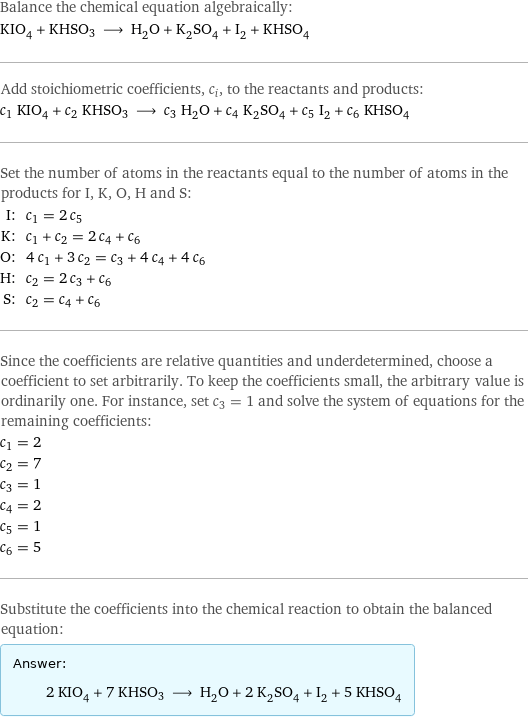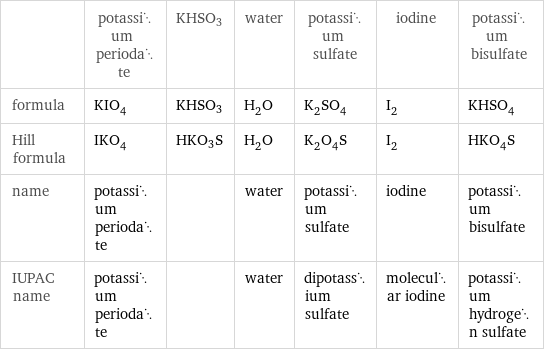Input interpretation

KIO_4 potassium periodate + KHSO3 ⟶ H_2O water + K_2SO_4 potassium sulfate + I_2 iodine + KHSO_4 potassium bisulfate
Balanced equation

Balance the chemical equation algebraically: KIO_4 + KHSO3 ⟶ H_2O + K_2SO_4 + I_2 + KHSO_4 Add stoichiometric coefficients, c_i, to the reactants and products: c_1 KIO_4 + c_2 KHSO3 ⟶ c_3 H_2O + c_4 K_2SO_4 + c_5 I_2 + c_6 KHSO_4 Set the number of atoms in the reactants equal to the number of atoms in the products for I, K, O, H and S: I: | c_1 = 2 c_5 K: | c_1 + c_2 = 2 c_4 + c_6 O: | 4 c_1 + 3 c_2 = c_3 + 4 c_4 + 4 c_6 H: | c_2 = 2 c_3 + c_6 S: | c_2 = c_4 + c_6 Since the coefficients are relative quantities and underdetermined, choose a coefficient to set arbitrarily. To keep the coefficients small, the arbitrary value is ordinarily one. For instance, set c_3 = 1 and solve the system of equations for the remaining coefficients: c_1 = 2 c_2 = 7 c_3 = 1 c_4 = 2 c_5 = 1 c_6 = 5 Substitute the coefficients into the chemical reaction to obtain the balanced equation: Answer: | | 2 KIO_4 + 7 KHSO3 ⟶ H_2O + 2 K_2SO_4 + I_2 + 5 KHSO_4
Structures

+ KHSO3 ⟶ + + +
Names

potassium periodate + KHSO3 ⟶ water + potassium sulfate + iodine + potassium bisulfate
Equilibrium constant
![K_c = ([H2O] [K2SO4]^2 [I2] [KHSO4]^5)/([KIO4]^2 [KHSO3]^7)](../image_source/99e6f69674d06711b1909edd3c84bbc6.png)
K_c = ([H2O] [K2SO4]^2 [I2] [KHSO4]^5)/([KIO4]^2 [KHSO3]^7)
Rate of reaction
![rate = -1/2 (Δ[KIO4])/(Δt) = -1/7 (Δ[KHSO3])/(Δt) = (Δ[H2O])/(Δt) = 1/2 (Δ[K2SO4])/(Δt) = (Δ[I2])/(Δt) = 1/5 (Δ[KHSO4])/(Δt) (assuming constant volume and no accumulation of intermediates or side products)](../image_source/f7cb001d00f214fb24c5be6d65f17a88.png)
rate = -1/2 (Δ[KIO4])/(Δt) = -1/7 (Δ[KHSO3])/(Δt) = (Δ[H2O])/(Δt) = 1/2 (Δ[K2SO4])/(Δt) = (Δ[I2])/(Δt) = 1/5 (Δ[KHSO4])/(Δt) (assuming constant volume and no accumulation of intermediates or side products)
Chemical names and formulas

| potassium periodate | KHSO3 | water | potassium sulfate | iodine | potassium bisulfate formula | KIO_4 | KHSO3 | H_2O | K_2SO_4 | I_2 | KHSO_4 Hill formula | IKO_4 | HKO3S | H_2O | K_2O_4S | I_2 | HKO_4S name | potassium periodate | | water | potassium sulfate | iodine | potassium bisulfate IUPAC name | potassium periodate | | water | dipotassium sulfate | molecular iodine | potassium hydrogen sulfate
Substance properties

| potassium periodate | KHSO3 | water | potassium sulfate | iodine | potassium bisulfate molar mass | 229.999 g/mol | 120.2 g/mol | 18.015 g/mol | 174.25 g/mol | 253.80894 g/mol | 136.16 g/mol phase | solid (at STP) | | liquid (at STP) | | solid (at STP) | solid (at STP) melting point | 582 °C | | 0 °C | | 113 °C | 214 °C boiling point | | | 99.9839 °C | | 184 °C | density | 3.618 g/cm^3 | | 1 g/cm^3 | | 4.94 g/cm^3 | 2.32 g/cm^3 solubility in water | | | | soluble | | surface tension | | | 0.0728 N/m | | | dynamic viscosity | | | 8.9×10^-4 Pa s (at 25 °C) | | 0.00227 Pa s (at 116 °C) | odor | | | odorless | | |
Units
